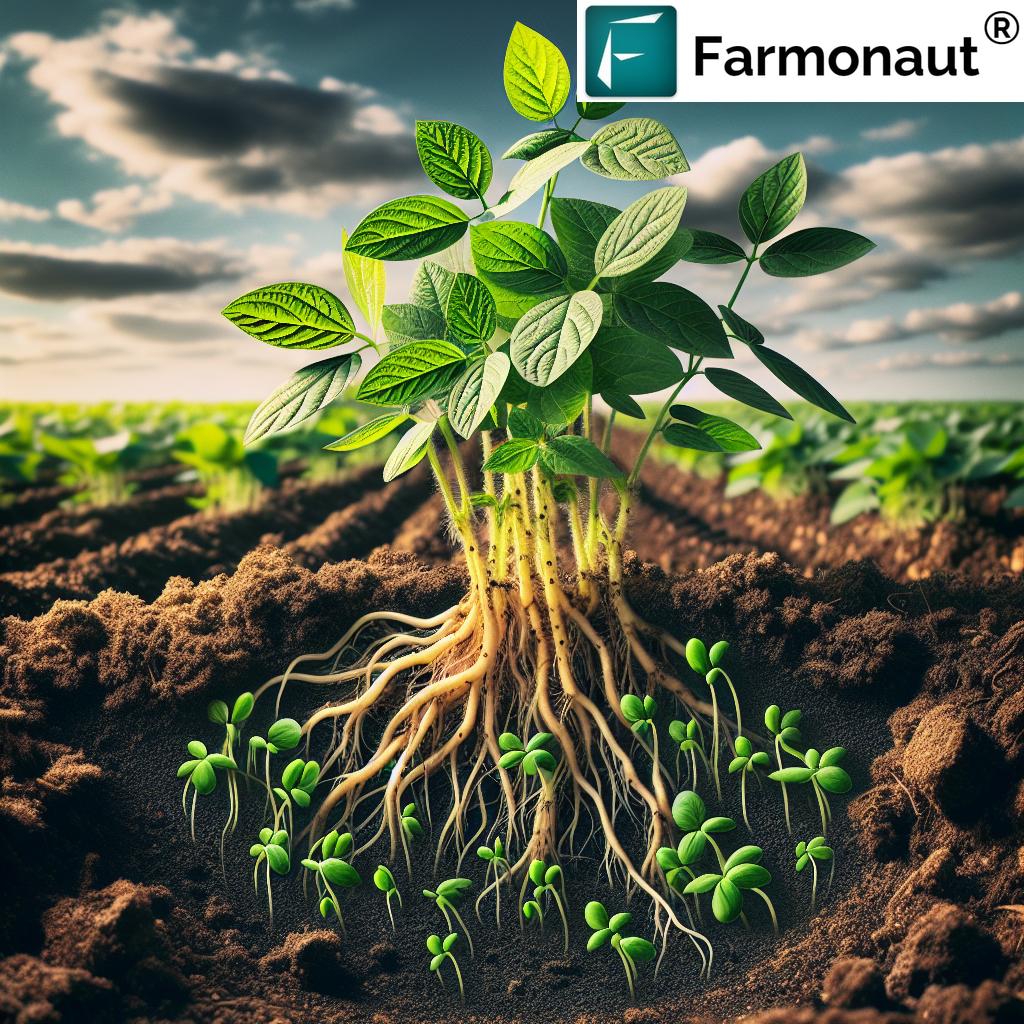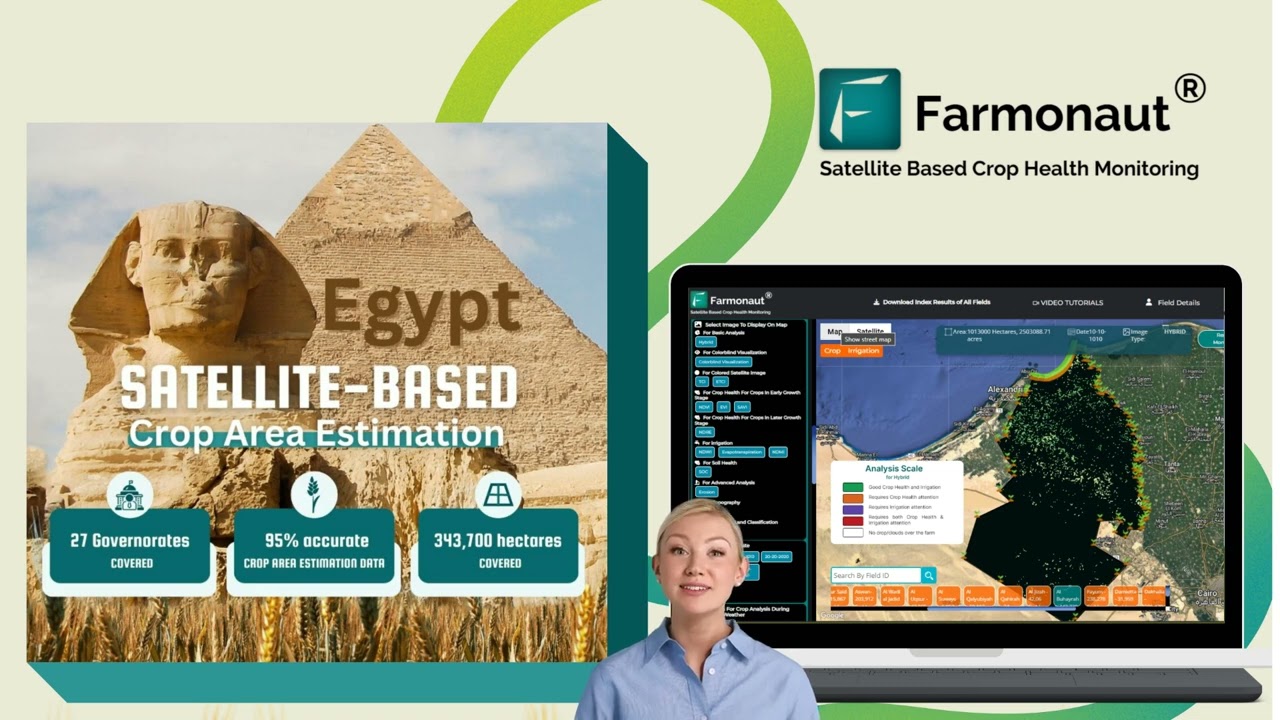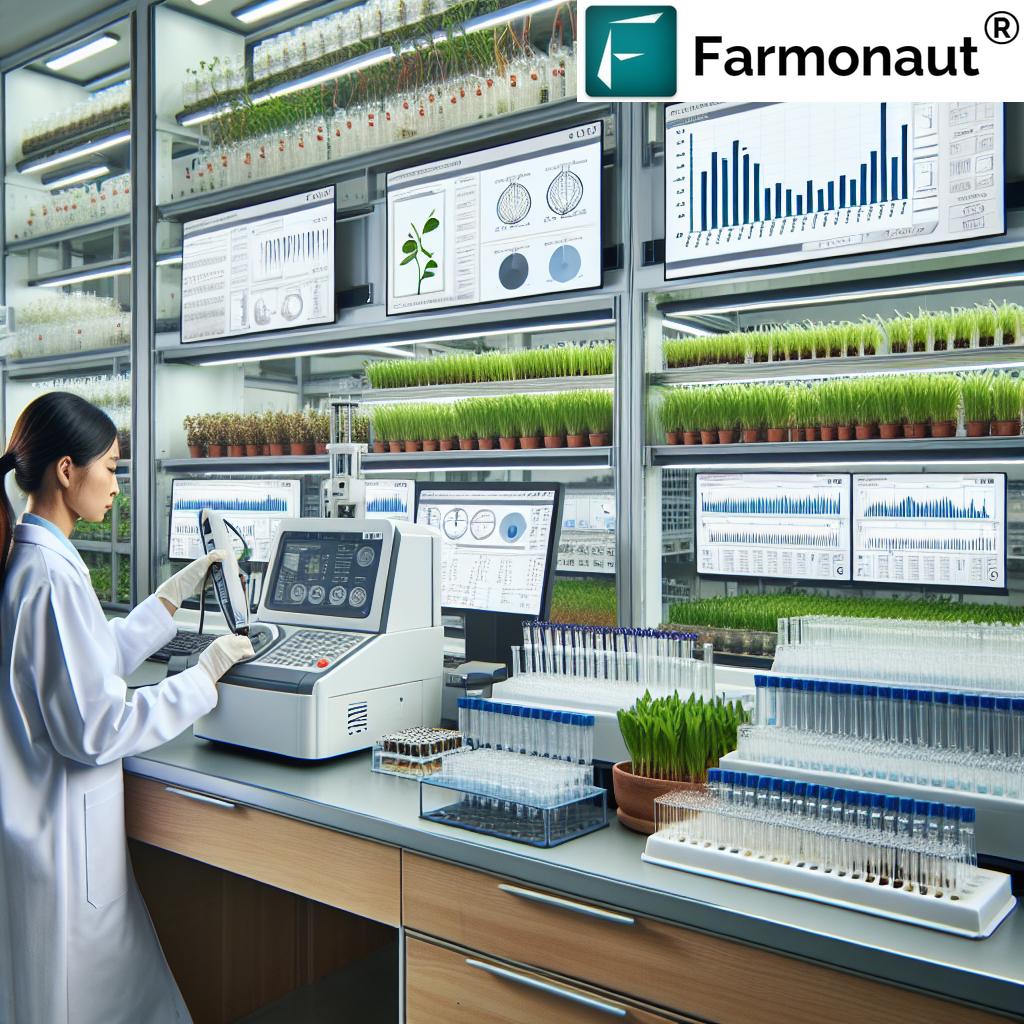Soybean Soil Mastery: 7 Powerful Practices for Higher Yields
Table of Contents
- Introduction
- Trivia: Soil pH & Crop Rotation Impact
- Soil Characteristics for Soybean Cultivation
- 7 Powerful Soil Management Practices
- Comparison Table of Key Soil Management Practices
- Farmonaut’s Smart Solutions for Soybean Farmers
- Pest and Disease Management for Soybean Soil Health
- Climate Considerations for Soybean Success
- FAQ: Frequently Asked Questions
- Conclusion: Achieving Soybean Soil Mastery
“Maintaining soil pH between 6.0 and 6.5 can increase soybean yields by up to 20%.”
Introduction
Soybeans (Glycine max) stand as a global staple crop, cherished for their remarkable nutritional content and unparalleled versatility. As we pursue higher yields and sustainable farming, we must recognize that the journey to optimal soybean production begins in the soil beneath our feet. Mastery over the soil—through understanding its properties, managing its nutrient and water content, and embracing sustainable practices—can transform soybean cultivation, enabling us to boost productivity, minimize environmental impacts, and ensure the long-term viability of our farming enterprises.
In this comprehensive guide, we delve into the 7 most powerful practices for soybean soil management. We explore optimal soil pH for soybeans, nutrient strategies, crop rotation, cover cropping, tillage methods, soil compaction mitigation, and water management. Whether you are a smallholder or manage large-scale farms, these science-backed approaches empower us to achieve improved soybean yields, healthier crops, and greater environmental stewardship.
Soil Characteristics for Soybean Cultivation
Before we implement advanced soil management practices, it is critical to understand the core characteristics that define the best soil for soybean cultivation. Let’s explore the foundational soil attributes that underpin soybean health, growth, and yield potential.
1. Soil Type and Texture: The Foundation of Soybean Growth
Soybeans flourish in well-drained, loamy soils with a balanced mixture of sand, silt, and clay. This unique texture achieves equilibrium between water retention and drainage:
- Sandy soils can drain quickly, risking moisture deficits, especially during dry spells.
- Clayey soils often retain excessive water, aggravating root rot and other diseases.
- Loam, combining sand, silt, and clay, offers optimal drainage, aeration, and nutrient availability.
Our goal is to select or amend fields to achieve a loamy texture, preventing growth-limiting issues like drought stress, root rot, or nutrient losses due to over-drainage.
References: Soil Requirements for Soybeans
2. Optimal Soil pH for Soybeans: Why It Matters
Soil pH significantly influences nutrient availability and the efficiency of biological nitrogen fixation—a crucial trait of soybeans as legumes. The optimal range is:
- pH 6.0–7.0, with the sweet spot at 6.3–6.5.
Within this band:
- Essential nutrients are most available and accessible to roots.
- Beneficial soil organisms thrive, supporting healthy plant growth.
- Deviations can cause deficiencies or toxicities (e.g., iron in alkaline, manganese in acidic soils).
A focus on soil testing for pH and timely liming (or acidulation, if required) is key for soybean soil management.
References: Managing Soil pH for Optimal Soybean Production
“Crop rotation with soybeans reduces soil-borne diseases, boosting yields by approximately 10% compared to monoculture.”
3. Soil Fertility for Soybeans: Beyond Nitrogen Fixation
It’s a common misconception that soybeans, being nitrogen-fixing, require no fertilizer. In reality:
- Phosphorus is vital for energy transfer, flowering, and pod development.
- Potassium enhances root strength and water regulation.
- Sulfur and micronutrients (e.g., B, Mn, Zn) are critical for enzyme function, growth, and disease resistance.
We recommend soil testing every three to four years to monitor fertility levels, guide precise fertilization, and avoid unwanted environmental impact.
References: Soybean Fertility Management
7 Powerful Soil Management Practices for Improving Soybean Yields
Mastering soybean yields is an art and science. Let’s dive deep into the seven pivotal soil management practices—each boosting not only yields, but also soil and environmental health.
1. Conservation Tillage Methods: Building Soil Organic Matter & Structure
Conservation tillage—including no-till and strip-till—has revolutionized modern soybean farming. Compared to traditional tillage, these methods:
- Minimize soil disturbance, preserving precious soil organic matter.
- Reduce erosion by shielding topsoil with residue cover.
- Enhance water retention and infiltration rates.
- Support a web of beneficial soil organisms, including earthworms and microbes.
In practice, however, it’s crucial to:
- Monitor for compaction and manage residue to prevent cold, wet seedbeds.
- Adjust equipment for residue handling.
Efficient conservation tillage is central to sustainable soybean farming practices, improving yields and long-term soil fertility.
References: Conservation Tillage in Soybean Systems
2. Cover Cropping for Soybeans: Nutrient Cycling and Soil Protection
Cover cropping involves planting protective crops such as rye or oats between main crop seasons. This sustainable practice:
- Reduces soil erosion by shielding the soil surface from wind and rain.
- Improves soil organic matter, vital for structure and water holding.
- Enhances nutrient cycling. When the cover crop decomposes, nutrients are released for the subsequent soybean crop, reducing need for synthetic fertilizers.
- Suppresses weed growth and interrupts disease and pest cycles.
Cover cropping for soybeans is a win-win: it improves both yields and environmental stewardship, supporting sustainable soybean farming practices.
References: Sustainable Cover Cropping in Soybean Production
3. Soybean Crop Rotation Practices: Breaking Pest and Disease Cycles
Continuous soybean monoculture leads to a buildup of pests (like SCN) and soil-borne diseases, plus exhaustion of specific soil nutrients. Rotation is one of our most powerful tools:
- Rotate soybeans with cereals (corn, wheat), thereby breaking cycles of specific pests and diseases.
- Enhance biodiversity—rotation promotes soil and crop diversity, improving overall farm resilience.
- Improve nutrient availability and reduce input requirements.
A two-or three-year rotation plan is recommended for maximizing yield and soil health—foundational in any robust soybean soil management system.
References: Soybean Crop Rotation Practices
4. Soil Testing and Fertilization: Precision for Soybean Nutrient Requirements
Regular, laboratory-based soil testing is the cornerstone of efficient nutrient management:
- Identifies existing levels of phosphorus, potassium, sulfur, calcium, and many micronutrients.
- Guides site-specific, need-based fertilization—minimizing excesses and preventing deficiencies.
- Reduces environmental impact by minimizing unnecessary fertilizer use.
Infuse these principles into your fertilization programs using insights from Farmonaut’s real-time satellite crop health and soil moisture monitoring for ultimate precision.
References: Fertility Guidelines for Soybeans
🧐 Did you know?
You can integrate powerful data through the Farmonaut Satellite & Weather API for automated monitoring and insights—ideal for both developers and advanced agribusinesses. See the API developer documentation for more.
5. Managing Soil Compaction in Soybeans: Unlocking the Hidden Yield Potential
Soil compaction restricts root growth, limits water and air exchange, and traps nutrients above compacted “pans.” Our advice:
- Avoid driving heavy equipment when soils are wet.
- Regularly monitor soil structure, using penetrometers or simple spade tests.
- If compaction is detected, apply subsoiling or similar mechanical loosening to break restrictive layers.
- Utilize controlled-traffic farming and deep-rooted cover crops (like radish) to help improve structure over time.
A focus on managing soil compaction in soybeans directly leads to improving soybean yields, root health, and resilience against drought.
References: Best Practices for Soil Compaction in Soybeans
6. Water Management: Striking the Balance for Soybean Success
Water stress—either deficits or excesses—is a primary yield-limiting factor in soybean production. Our management principles:
- Ensure adequate drainage (via tile drains or contouring) to avoid root rot in heavy/clayey soils.
- Enhance retention in sandy soils by adding organic matter or optimizing irrigation scheduling.
- Soybeans require approximately 510–660 mm of water through the season. Time irrigation to critical growth stages for maximum yield impact.
References: Water Needs for Growing Soybeans
7. Organic Amendments and Soil Health Enhancers
Addition of compost, manure, and crop residues significantly enhances soil organic matter, promoting:
- Improved water retention and soil structure.
- Increased microbial activity—crucial for nutrient cycling and disease suppression.
- Long-term increases in soil fertility for soybeans and resilience against environmental stressors.
Comparison Table of Key Soil Management Practices and Their Impact on Soybean Yield
| Practice | Estimated Yield Improvement (%) | Sustainability Benefits | Environmental Impact |
|---|---|---|---|
| Optimal Soil pH | Up to 20% | Maximizes nutrient availability; supports beneficial microbes | Reduces input need; minimizes toxicities |
| Nutrient Management | 10–15% | Improves root and shoot growth; balanced nutrition | Reduces fertilizer runoff and excesses |
| Crop Rotation | ~10% | Reduces pest/disease pressure; increases soil biodiversity | Limits pesticide usage; prevents soil degradation |
| Cover Cropping | 5–10% | Erosion control; organic matter boost | Enhances carbon sequestration; suppresses weeds naturally |
| Reduced Tillage | 5–12% | Preserves structure; encourages soil life | Lowers carbon emissions & fuel need |
| Organic Amendments | 8–15% | Builds soil fertility and carbon stores | Long-term carbon storage; reduced input needs |
| Water Management | 10–18% | Balances moisture; reduces erosion risk | Minimizes water wastage; prevents leaching |
Farmonaut’s Smart Solutions for Soybean Soil Management & Yield Maximization
Achieving soybean soil mastery demands more than traditional know-how—it requires real-time data, precision monitoring, and streamlined resource management. Farmonaut offers a comprehensive platform that truly empowers us to improve yields, enhance sustainability, and minimize environmental impact.
- Satellite-Based Crop Health Monitoring: Receive NDVI, NDWI, and soil moisture insights to guide fertilization, irrigation, and pest management for soybeans—directly on your mobile, web, or API dashboards.
- Jeevn AI Advisory System: Get personalized, AI-driven advisories to optimize every stage of your soybean growing season, leveraging satellite and field data for smarter decisions.
- Blockchain-Based Traceability: Deploy Farmonaut’s traceability solutions for supply chain verification—building consumer trust for soybeans and processed products.
- Fleet and Resource Management: Scale your operation and streamline transport with Farmonaut’s fleet management tools. Reduce fuel waste and operating costs for medium and large farms.
- Carbon Footprinting: Track your environmental progress with the Farmonaut carbon footprint tool—monitor greenhouse gas emissions from your farm and showcase sustainable soybean farming practices to buyers and regulators.
- Support for Large-Scale Growers: Unlock additional features for multiple fields, staff management, and advanced reporting through Farmonaut’s large-scale farm management solutions.
- Facilitate Crop Loans and Insurance: Get satellite-verifiable evidence for quick loan disbursal and insurance with Farmonaut’s crop loan & insurance services.
Ready to experience the next generation of soybean farming? Explore Farmonaut’s platform on web, Android, and iOS for actionable insights that maximize yield and profit while promoting a healthy planet.
Pest and Disease Management for Soybean Soil Health
Maintaining optimal soil conditions and yield is impossible without comprehensive pest and disease management in our soil management strategy.
Soybean Cyst Nematode (SCN): The Underground Menace
SCN is a microscopic nematode and one of the most destructive soybean pests, notorious for silently causing root damage and yield loss. Our integrated approach:
- Implement soybean crop rotation practices with non-host crops to break the SCN life cycle.
- Plant SCN-resistant soybean varieties where nematode populations threaten productivity.
- Minimize consistent tillage, which can spread nematodes between fields.
- Monitor SCN levels through regular soil testing—act promptly if populations rise above threshold.
References: Soybean Cyst Nematode (SCN)
Integrated Pest Management (IPM): The Sustainable Choice
IPM is about integrating biological, cultural, and chemical controls for improved soybean yields and reduced pesticide reliance. Our IPM toolkit:
- Use cover crops to suppress weeds and reduce alternative pest habitats.
- Promote beneficial insects and natural predators by preserving biodiversity.
- Monitor pest levels, applying interventions only when critical thresholds are reached.
References: Integrated Pest Management in Agriculture
Climate Considerations: Adapting Soybean Soil Practices for Maximum Yield
While soybeans are adaptable, climatic factors have a major influence on soil health and yield outcomes. Best practices:
- Temperature: 77°F–86°F (25–30°C) is ideal during most of the growing season. Both cold and excessive heat can stress roots and delay development.
- Moisture: 510–660 mm (20–26 inches) of water needed per season. Plan drainage for heavy rains and irrigation for dry spells.
- Soil Management Adaptations: Adjust tillage, rotation, and water management based on predicted climate patterns, balancing moisture retention and drainage.
References: How to Grow Soybeans: Climate Insights
Frequently Asked Questions: Soybean Soil Mastery & Farmonaut Solutions
Q1: What is the best soil for soybean cultivation?
We recommend well-drained, loamy soils with balanced sand, silt, and clay composition. This optimizes root health, nutrient uptake, and prevents moisture imbalances.
Q2: How often should we test soil for soybeans?
Test your fields every 3–4 years for nutrients and pH, or annually if you suspect deficiencies or want to fine-tune your fertilization program, especially when transitioning to new management practices.
Q3: How does Farmonaut help with soybean soil management?
Farmonaut provides real-time crop health and soil moisture monitoring using satellite imagery, alongside AI-based advisories and predictive analytics for irrigation, fertilization, and pest management. This empowers both small and large-scale farms to make evidence-based decisions and boost yields efficiently.
Q4: What are the signs of soil compaction in soybeans?
You may notice stunted root systems, water pooling after rain, slow crop emergence, and lower yields. Farmers can use a penetrometer or even a simple digging tool to check for dense, platy soil layers at rooting depth.
Q5: How do organic amendments boost soybean yields?
Organic matter increases the soil’s water-holding capacity, supports beneficial organisms, and improves overall fertility. This leads to enhanced root growth and yield stability, especially in weather extremes.
Q6: Can Farmonaut support sustainability initiatives or certifications?
Yes. Farmonaut’s carbon footprinting solutions help you measure, monitor, and report your farm’s environmental progress, supporting sustainability goals and compliance needs.
Conclusion: Achieving Soybean Soil Mastery for Profitable and Sustainable Farming
The path to maximizing soybean yields is rooted in the health and management of our soil. Mastery comes from comprehensively understanding soil characteristics—from texture and pH to fertility and structure—and applying the seven powerful practices detailed above. With regular soil testing, rotation, cover cropping, organic amendments, compaction management, conservation tillage, and precise water control, we collectively ensure higher yields, lower input costs, and a healthier farming ecosystem.
Farmonaut stands at the leading edge of precision agriculture, offering cost-effective and data-driven solutions for all farmers. By combining satellite monitoring, AI advisories, carbon tracking, and more, Farmonaut empowers us to enlarge our harvests, protect our soils, and future-proof our businesses. As we champion sustainable soybean farming practices, let us put these science-backed methods—and the best available technologies—into action for greater yields and a greener world.
Ready to transform your soil and maximize your soybean success? Get started with Farmonaut’s app or integrate advanced satellite data via API today!




















